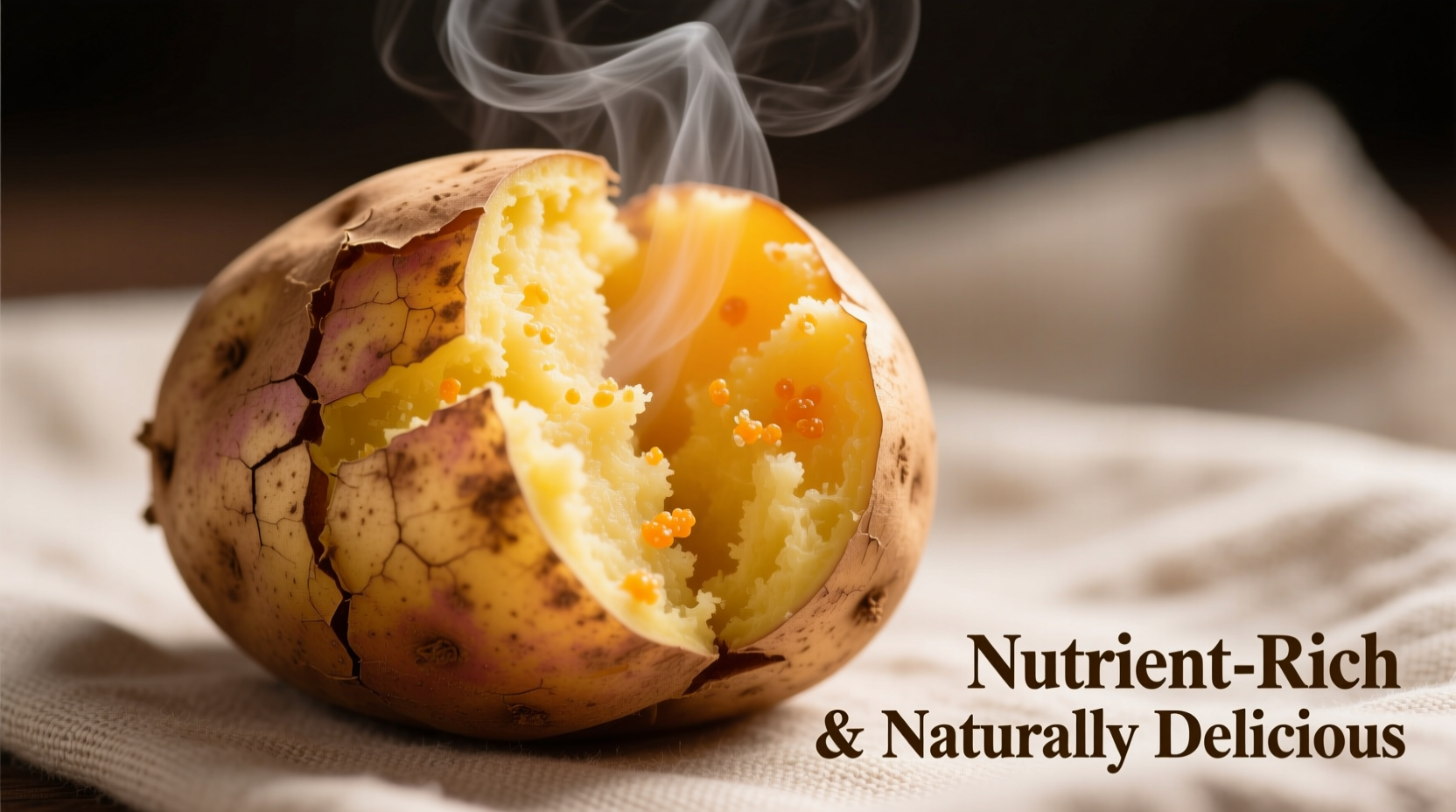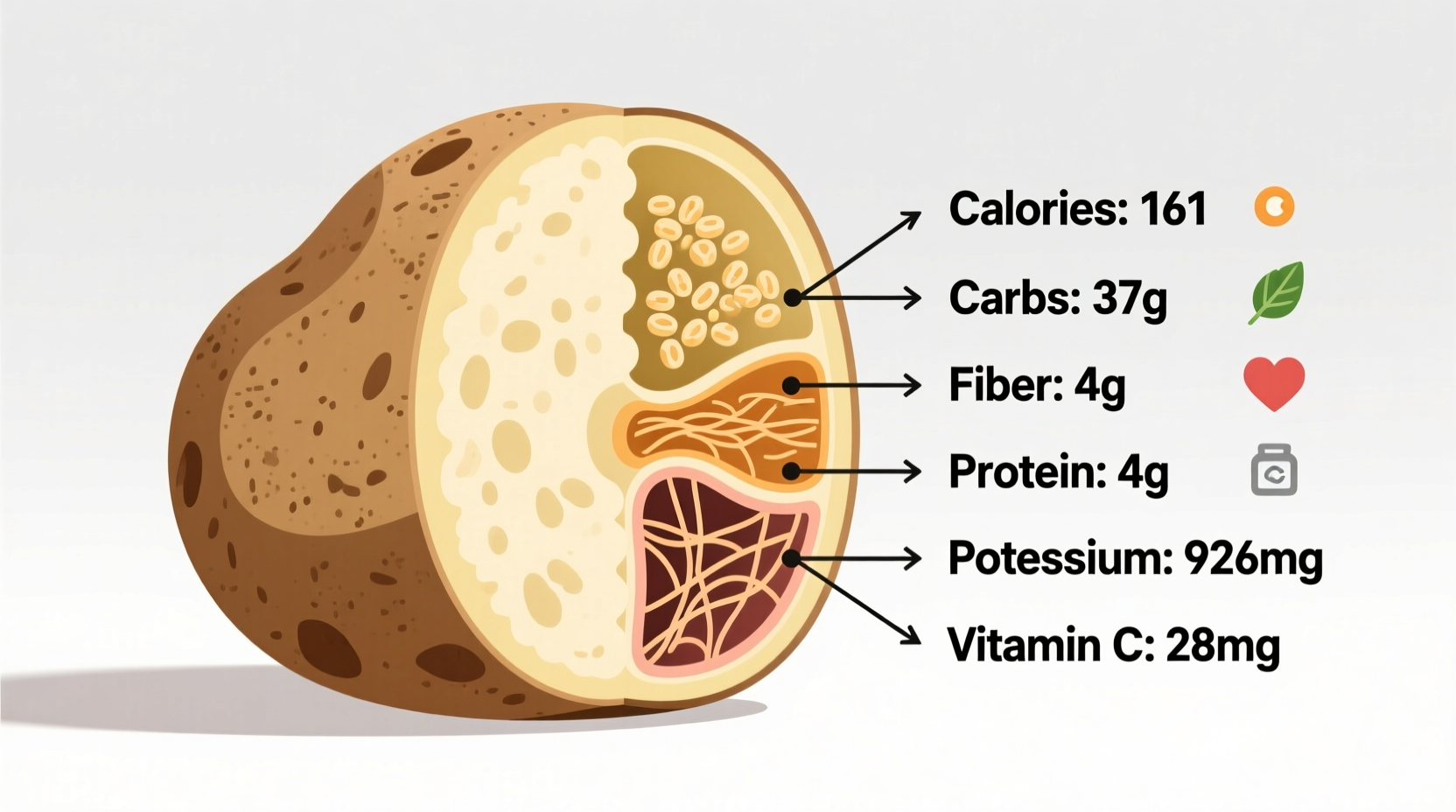A medium baked potato (173g, with skin) contains approximately 168 calories, 37g of carbohydrates, 4.3g of protein, 0.2g of fat, and 3.8g of fiber. It's particularly rich in potassium (26% of daily value), vitamin C (28%), and vitamin B6 (27%), making it a nutrient-dense food that supports heart health, digestion, and immune function when consumed as part of a balanced diet.
Discover exactly what makes baked potatoes a nutritional powerhouse and how they compare to other preparation methods. Whether you're managing blood sugar, tracking macros, or simply curious about this humble staple, you'll get science-backed facts to make informed dietary choices.
Nutritional Profile of Baked Potatoes: What's Inside
When you choose baking as your cooking method, you preserve more nutrients than boiling or frying. The dry heat of baking helps maintain water-soluble vitamins that would otherwise leach into cooking water. Let's break down exactly what's in a medium baked potato (173g) with skin, according to USDA FoodData Central:
| Nutrient | Amount | % Daily Value |
|---|---|---|
| Calories | 168 | 8% |
| Carbohydrates | 37g | 13% |
| Fiber | 3.8g | 14% |
| Protein | 4.3g | 9% |
| Potassium | 926mg | 26% |
| Vitamin C | 17.3mg | 28% |
| Vitamin B6 | 0.5mg | 27% |
| Magnesium | 48mg | 12% |
Why Potato Skin Matters for Nutrition
Many people automatically peel potatoes before eating, but you'd be discarding up to 50% of the fiber and significant amounts of nutrients. Research from the Saskatchewan Ministry of Agriculture confirms that potato skins contain concentrated levels of antioxidants, fiber, and minerals. When baked with skin intact, potatoes retain more nutrients compared to peeled preparations.

How Baking Affects Nutritional Value
The cooking method significantly impacts the nutritional profile of potatoes. Baking preserves more nutrients than boiling because it doesn't cause water-soluble vitamins to leach out. According to a study published in Foods journal, baking maintains higher levels of vitamin C and potassium compared to boiling.
| Cooking Method | Glycemic Index | Vitamin C Retention | Key Nutritional Differences |
|---|---|---|---|
| Baked (with skin) | 60-70 | 70-80% | Higher fiber, more potassium, better nutrient retention |
| Boiled (peeled) | 70-85 | 40-50% | Lower calorie density, but significant nutrient loss to water |
| Fried | 70-80 | 50-60% | Higher calories and fat, acrylamide formation at high temperatures |
Health Benefits of Baked Potatoes
Baked potatoes offer several science-backed health benefits when consumed as part of a balanced diet:
Heart Health Support
The high potassium content (926mg per medium potato) helps regulate blood pressure. According to the American Heart Association, increasing potassium intake while reducing sodium can significantly lower cardiovascular disease risk.
Digestive Health
With 3.8g of fiber (14% of daily needs), baked potatoes support healthy digestion. The resistant starch formed when cooled potatoes are reheated acts as a prebiotic, feeding beneficial gut bacteria according to research from the National Center for Biotechnology Information.
Blood Sugar Management Considerations
While potatoes have a moderate glycemic index (60-70), their impact on blood sugar can be managed. The Centers for Disease Control and Prevention notes that pairing potatoes with protein and healthy fats slows glucose absorption. Cooling and reheating baked potatoes increases resistant starch content by up to 50%, which lowers the glycemic response.
Practical Tips for Maximizing Nutritional Value
Get the most nutritional benefit from your baked potatoes with these evidence-based strategies:
- Always bake with skin on - The skin contains up to 50% of the fiber and concentrated nutrients
- Cool before eating - Cooling increases resistant starch content by 2-3 times, improving blood sugar response
- Pair with healthy fats - Adding a small amount of olive oil or avocado enhances absorption of fat-soluble vitamins
- Combine with protein - Adding Greek yogurt, beans, or lean meats creates a more balanced meal
- Avoid excessive toppings - Butter, sour cream, and cheese can significantly increase calories and saturated fat
When Baked Potatoes Might Not Be Ideal
While nutritious, baked potatoes have some context-specific limitations to consider:
- For strict low-carb diets - At 37g of carbohydrates, they exceed limits for ketogenic diets
- For certain digestive conditions - The resistant starch may cause discomfort for some with IBS
- When prepared with high-calorie toppings - A plain baked potato is nutrient-dense, but loaded versions can become calorie-dense
Registered dietitians from the Academy of Nutrition and Dietetics emphasize that potatoes are healthiest when prepared simply and consumed as part of a varied diet rich in vegetables, lean proteins, and healthy fats.
Putting Baked Potatoes in Your Meal Plan
Here's how to incorporate baked potatoes into different dietary patterns:
- For weight management: Use as a 1/2 to 1 cup serving alongside non-starchy vegetables and lean protein
- For athletic performance: Consume within 2 hours post-workout for optimal glycogen replenishment
- For diabetes management: Pair with protein and healthy fats, and consider cooling before eating
- For general health: Enjoy 1-2 times weekly as part of a varied vegetable intake
Remember that individual nutritional needs vary based on age, activity level, and health conditions. Consulting with a registered dietitian can help you determine the right portion size and frequency for your specific goals.











 浙公网安备
33010002000092号
浙公网安备
33010002000092号 浙B2-20120091-4
浙B2-20120091-4